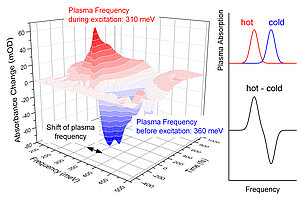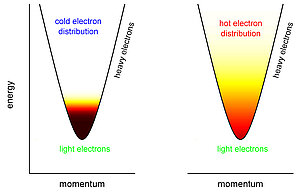A plasma is a special state of matter in which a large number of electrons form a negatively charged cloud that can shift against the positively charged background of the ions. Plasmas are found in a variety of systems, including hot stars, the ionosphere and other ionized gases, as well as solid state materials. The electric forces between electrons and ions allow temporally periodic movements of the electron cloud with respect to the ion background, the so-called plasma oscillations or plasons. Interest in plasmon in metals and semiconductors has been growing lately. Their outstanding optical properties have promising potential for applications in high-speed optoelectronics and sub-wavelength resolution optical microscopy.
Heat makes you limp: light slows down the vibrations of an electron plasma
Fig. 1 Experimentally observed time-dependent shift of plasma frequency in a thin ZnO layer. Left: 3D graph of the absorption change as a function of the sampling frequency and the delay time between excitation and sampling light pulses. Right: concept of a transient difference spectrum. The cold plasma (blue) shows an absorption line at the plasma frequency of the cold electron gas. The excitation light pulse heats the plasma, which leads to a red shift of the plasmon resonance (red). In the time-resolved experiments, the so-called difference spectrum is measured, that is, the absorption line of the hot plasma minus that of the cold plasma (black).
A fundamental and interesting question is the following: Can one manipulate plasma oscillations with light, say change their frequency? This could switch the electrical and optical properties on very short time scales, an ideal instrument for modern optoelectronics. In the most recent issue of the journal Physical Review Letters [115, 147401 (2015)], a research team from the Max Born Institute and the Humboldt University in Berlin has demonstrated a new concept that allows ultrafast switching of plasmon in the semiconductor ZnO ( Movie). In their experiments, the scientists studied plasma oscillations in a 100 nanometer thick, crystalline ZnO layer containing a high density of approximately 1020 free electrons per cubic centimeter. An infrared light pulse of 150 fs duration (1 fs = 10-15 s) excited the plasma oscillations. Their frequency was measured by the infrared absorption of the plasma by means of a weaker sampling pulse time-resolved. From the shift of the absorption line, the instantaneous frequency of the plasma oscillations was determined (Figure 1). The experiments show a significant redshift, i. Reduction of the plasma frequency. However, the 20% reduction stops only 400 fs, after which the system returns to the original plasma frequency. Throughout the period of the experiment, the electron density remains unchanged.
Fig. 2 The conduction band of ZnO exhibits a so-called non-parabolic band structure, that is, the electron energy as a function of the electron impulse follows a hyperbola rather than a parabola. As a consequence, the electrons at the minimum of the conduction band are lighter (small energy, small mass) than the electrons at high particle energies (large mass). A cold plasma (left) contains essentially light electrons, while a hot plasma (right) has many heavy electrons at high energies.
The physical cause of the redshift is the temporary heating of the electron plasma by the infrared excitation pulse. The electrons reach a peak temperature of about ≈3300 K and populate a wide range of the conduction band of ZnO (Figure 2). In this range, the average electron mass is significantly higher than in the initial state, which leads to a decrease in the plasma frequency. The hot electrons lose most of their energy to the crystal lattice within the first 400 fs with the result that both the average mass and the plasma frequency return to their original values. All experimental observations are in excellent agreement with theoretical model calculations.
Animation: Right: Plasma oscillations in a thin ZnO layer. Negatively charged electrons (blue clouds) oscillate towards positively charged ions (red spheres). Left: Such a plasma oscillation resembles strongly a classical pendulum, here a massive ball on an elastic spring. (i) At negative times t <0, the oscillation frequency is very high due to the small mass of electrons. (ii) During the period 0 <t <100 fs (top left time display), the excitation light pulse heats up the electron plasma (lighters below, temperature display top right). As a result, one obtains a larger mass of electrons or weight in the pendulum. (iii) For t> 100 fs, the sampling light pulse again measures the oscillation frequency, which now has a much lower value.
Search publications of MBI
Publications since 2025

